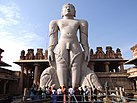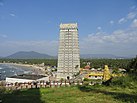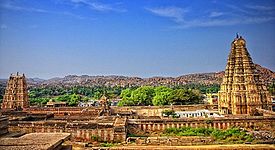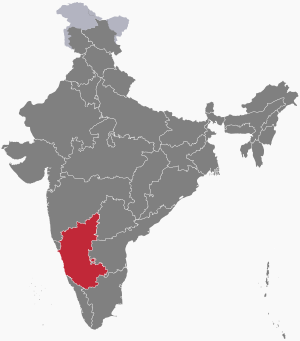
Back Karnataka ACE Karnataka AF ካርናተከ AM कर्नाटक ANP كرناتك Arabic كارناتاكا ARZ কৰ্ণাটক AS Karnataka AST कर्नाटक AWA Karnataka AZ
Karnataka (/kərˈnɑːtəkə/ kər-NAH-tə-kə; ISO: Karnāṭaka, Kannada: [kɐɾˈnaːʈɐkɐ]) is a state in the southwestern region of India. It was formed as Mysore State on 1 November 1956, with the passage of the States Reorganisation Act, and renamed Karnataka in 1973. The state is bordered by the Lakshadweep Sea to the west, Goa to the northwest, Maharashtra to the north, Telangana to the northeast, Andhra Pradesh to the east, Tamil Nadu to the southeast, and Kerala to the southwest. With 61,130,704 inhabitants at the 2011 census, Karnataka is the eighth-largest state by population, comprising 31 districts. With 15,257,000 residents, the state capital Bengaluru is the largest city of Karnataka.[15]
The economy of Karnataka is amongst the most productive in the country with a gross state domestic product (GSDP) of ₹25.01 trillion (US$290 billion) and a per capita GSDP of ₹332,926 (US$3,900) for the financial year 2023–24.[10][11] The state experience a GSDP growth of 10.2% for the same fiscal year.[10] After Bangalore Urban, Dakshina Kannada, Hubli–Dharwad, and Belagavi districts contribute the highest revenue to the state respectively. The capital of the state, Bengaluru, is known as the Silicon Valley of India, for its immense contributions to the country's information technology sector. A total of 1,973 companies in the state were found to have been involved in the IT sector as of 2007.[16]
Karnataka is the only southern state to have land borders with all of the other four southern Indian sister states. The state covers an area of 191,791 km2 (74,051 sq mi), or 5.83 per cent of the total geographical area of India.[17] It is the sixth-largest Indian state by area.[17] Kannada, one of the classical languages of India, is the most widely spoken and official language of the state. Other minority languages spoken include Urdu, Konkani, Marathi, Tulu, Tamil, Telugu, Malayalam, Kodava and Beary. Karnataka also contains some of the only villages in India where Sanskrit is primarily spoken.[18][19][20]
Though several etymologies have been suggested for the name Karnataka, the generally accepted one is that Karnataka is derived from the Kannada words karu and nādu, meaning "elevated land". Karu Nadu may also be read as karu, meaning "black" and nadu, meaning "region", as a reference to the black cotton soil found in the Bayalu Seeme region of the state. The British used the word Carnatic, sometimes Karnatak, to describe both sides of peninsular India, south of the Krishna.[21] With an antiquity that dates to the paleolithic, Karnataka has been home to some of the most powerful empires of ancient and medieval India. The philosophers and musical bards patronised by these empires launched socio-religious and literary movements which have endured to the present day. Karnataka has contributed significantly to both forms of Indian classical music, the Carnatic and Hindustani traditions.
- ^ Poem declared State Song[usurped] The Hindu – 11 January 2006
- ^ "Poem declared 'State song'". The Hindu. 11 January 2004. Archived from the original on 1 January 2016. Retrieved 22 May 2018.
- ^ "Rajneesh Goel Appointed As Karnataka's New Chief Secretary". NDTV. PTI. 22 November 2023. Archived from the original on 3 February 2024. Retrieved 3 February 2024.
- ^ "Karnataka CM swearing in ceremony live updates: 'In larger interest of party,' says DK Shivakumar on becoming deputy CM and Siddaramaiah as new CM". The Times of India. 18 May 2023. Archived from the original on 18 May 2023. Retrieved 18 May 2023.
- ^ "Protected Areas of India: State-wise break up of Wildlife Sanctuaries" (PDF). Wildlife Institute of India. Government of India. Archived (PDF) from the original on 24 October 2016. Retrieved 24 August 2016.
- ^ "Udupi-Chikmagalur: A constituency that's beset by problems". The Hindu. 18 March 2014. ISSN 0971-751X. Archived from the original on 24 March 2023. Retrieved 24 March 2023.
- ^ "Figures at a glance" (PDF). 2011 Provisional census data. Ministry of Home Affairs, Government of India. Archived (PDF) from the original on 24 October 2011. Retrieved 17 September 2011.
- ^ 50th Report of the Commission for Linguistic Minorities in India (PDF). National Commissioner Linguistic Minorities. p. 123. Archived from the original (PDF) on 8 July 2016.
- ^ "THE KARNATAKA OFFICIAL LANGUAGE ACT, 1963" (PDF). Archived (PDF) from the original on 15 January 2023. Retrieved 28 September 2022.
- ^ a b c Gross State Domestic Product (Current Prices) (Report). Government of India. Retrieved 1 November 2024.
- ^ a b Per Capita Net State Domestic Product (Current Prices) (Report). Government of India. Retrieved 1 November 2024.
- ^ "Sub-national HDI – Area Database". Global Data Lab. Institute for Management Research, Radboud University. Archived from the original on 23 September 2018. Retrieved 25 September 2018.
- ^ "Census 2011 (Final Data) – Demographic details, Literate Population (Total, Rural & Urban)" (PDF). planningcommission.gov.in. Planning Commission, Government of India. Archived from the original (PDF) on 27 January 2018. Retrieved 3 October 2018.
- ^ Huq, Iteshamul, ed. (2015). "Introduction" (PDF). A Handbook of Karnataka (Fifth ed.). Karnataka Gazetteer Department. p. 48. Archived (PDF) from the original on 23 May 2018. Retrieved 22 May 2018.
- ^ "Population" (PDF).
- ^ "Business News: Business News India, Business News Today, Latest Finance News, Business News Live". Financialexpress. 4 April 2024. Retrieved 4 April 2024.
- ^ a b "Census Reference Tables, B-Series - Area". censusindia.gov.in. Archived from the original on 14 June 2021. Retrieved 25 December 2021.
- ^ "Seven Indian villages where people speak in Sanskrit". 24 September 2017. Archived from the original on 7 April 2019. Retrieved 7 April 2019.
- ^ "Know about these 4 Indian villages where Sanskrit is still their first language". Archived from the original on 6 January 2019. Retrieved 7 April 2019.
- ^ "Five Indian villages where Sanskrit is spoken". Archived from the original on 7 April 2019. Retrieved 7 April 2019.
- ^ See Lord Macaulay's life of Clive and James Talboys Wheeler: Early History of British India, London (1878) p.98. The principal meaning is the western half of this area, but the rulers there controlled the Coromandel Coast as well.











